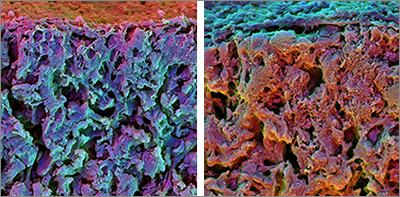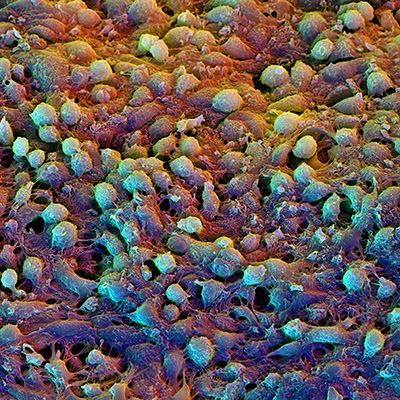A new hydrogel material allows for more control in the differentiation of stem cells into bone cells
(CAMBRIDGE, Mass.) — Researchers at the Wyss Institute for Biologically Inspired Engineering at Harvard University and the Harvard John A. Paulson School of Engineering and Applied Sciences (SEAS) have developed a new, more precise way to synthetically control differentiation of stem cells into bone cells by leveraging bioinspired hydrogels. This new technique has promising applications in the realm of bone regeneration, growth and healing. The research led by David Mooney, Ph.D., Wyss Institute Core Faculty member and Robert P. Pinkas Family Professor of Bioengineering at SEAS, was published on November 30 in Nature Materials.

The extracellular matrix, a microenvironment of proteins and polymers that surrounds and connects cells, impacts a range of cellular behaviors including differentiation. For about a decade, researchers have been able to direct the fate of stem cells by tuning the mechanical stiffness of synthetic microenvironments such as hydrogels. Stem cells in more flexible hydrogels have been shown to differentiate into fat cells while those in stiffer hydrogels are more likely to differentiate into osteogenic (bone) cells.
But tuning stiffness alone is not precise enough to overcome many of the challenges in differentiating and proliferating different types of stem cells. Only tuning the stiffness of a cell’s microenvironment assumes that the natural extracellular matrix behaves elastically like rubber. When force or stress is exerted on an elastic material, it is stored as energy, and when that force is removed the material bounces back to its original shape like a rubber band. In nature, however, extracellular matrices are not elastic — they are viscoelastic. Viscoelastic materials, such as chewing gum or Silly Putty, relax over time when force or stress is applied.
“This work both provides new insight into the biology of regeneration, and is allowing us to design materials that actively promote tissue regeneration,” said Mooney.
“We found that by increasing stress relaxation, especially combined with increased stiffness in the hydrogel, there is an increase of osteogenic differentiation,” said Luo Gu, Postdoctoral Fellow at SEAS and Wyss and co-first author on the paper. “With increased stress relaxation, there was also a decreases the differentiation of fat cells. This is the first time we’ve observed how stress relaxation impacts cell differentiation.”
Not only did increased stress relaxation dramatically increase early osteogenic differentiation but those cells continued to develop toward full-fledged bone cells.

One reason that fast-relaxing microenvironments promote more osteogenesis and form bone is that cells inside these matrices can mechanically remodel the matrix and more easily change shape, said Ovijit Chaudhuri, a former Postdoctoral Fellow at SEAS and Wyss and co-first author on the study. It may seem counterintuitive that bone cells need fast-relaxing environments to grow into fully-formed strong, stiff bones. However, the team observed that the natural microenvironment around bone fractures is very similar to the fastest-relaxing hydrogel the team developed in the lab.
“Coagulated bone marrow and blood near a fracture are very viscous,” Gu said. “This is a good indication that in the natural environment, when a bone fracture is healing, it needs a really fast-relaxing matrix to assist in bone growth.”
Although no single microenvironment parameter alone controls differentiation, Gu said, combined tuning of hydrogel stress relaxation responses with stiffness properties provides a new way to more precisely control stem cell differentiation and development. The next stage of the research is to test fast-relaxing hydrogels in vivo, to see if they promote bone healing.
The work was funded by the National Institute of Health, the Einstein Foundation Berlin and Harvard MRSEC.